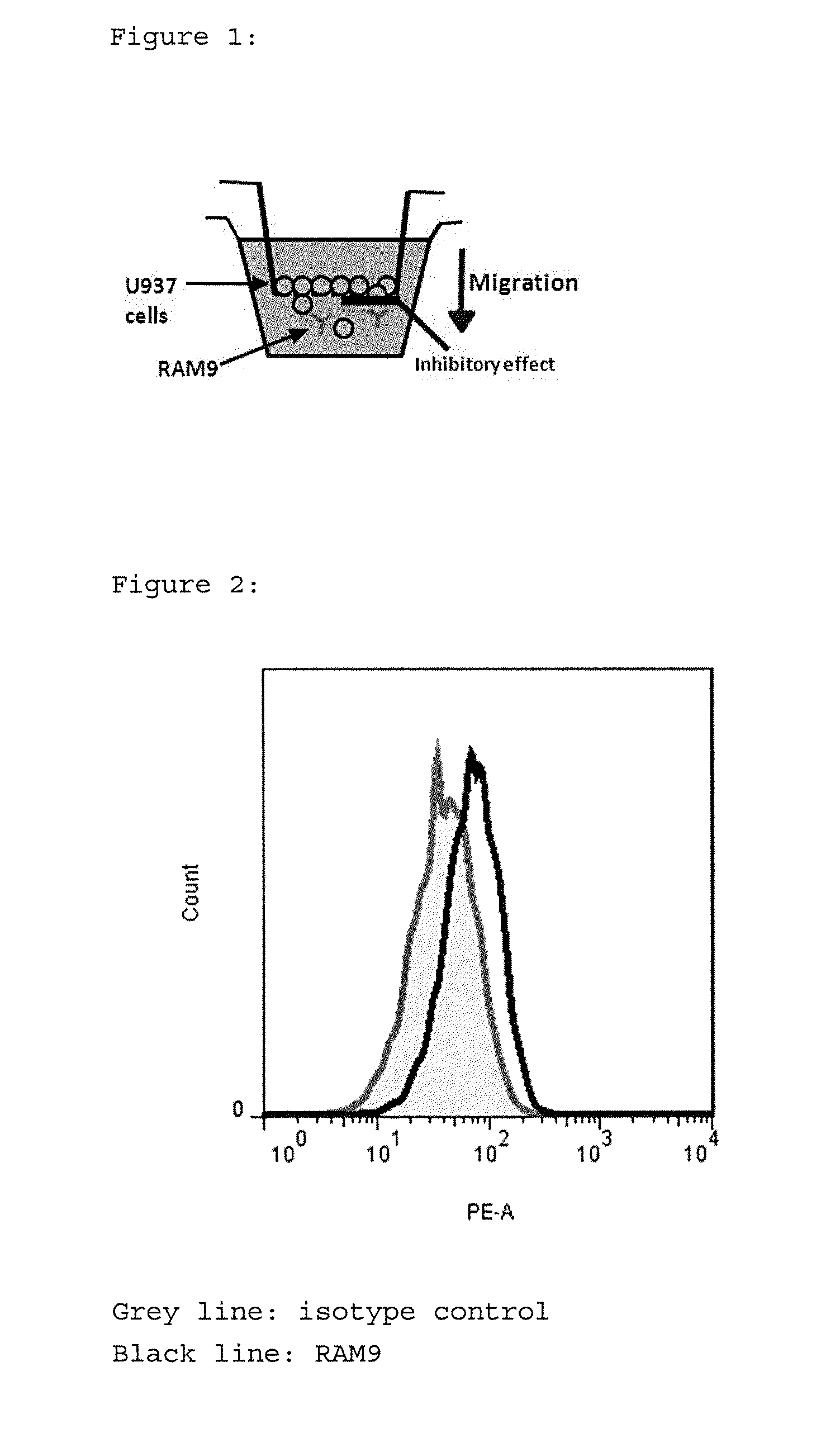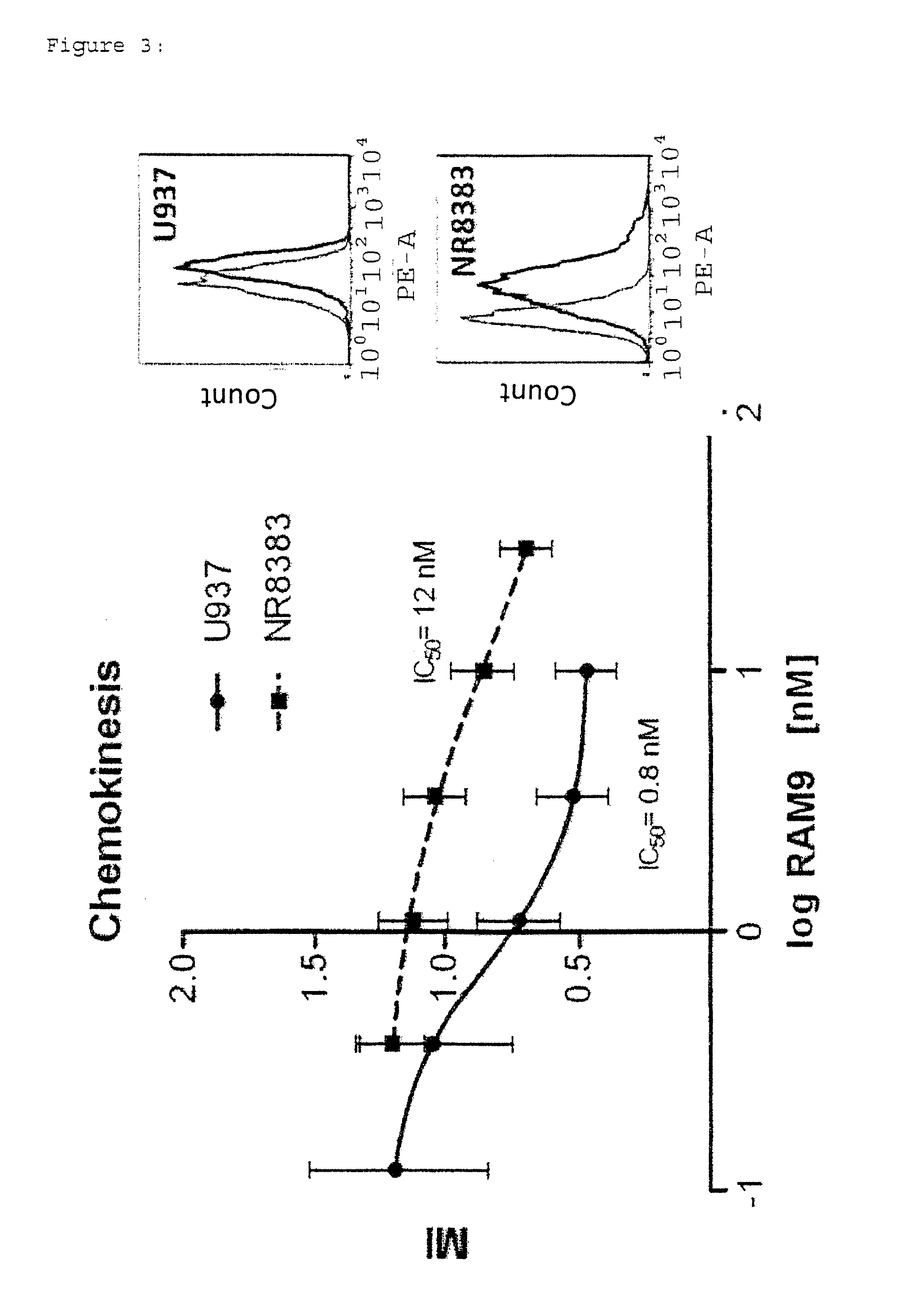Anti-mif antibody cell migration assay
a technology of antibody cell migration and anti-mif, which is applied in the field of anti-mif antibody cell migration assay, can solve the problems of inability to use the same for diagnosis or therapy, and no robust mif bioassay based on the inhibition of autocrine-induced cell migration of e.g. monocytic cells, and achieves the effect of reducing the number of false positives and reducing false negatives
- Summary
- Abstract
- Description
- Claims
- Application Information
AI Technical Summary
Benefits of technology
Problems solved by technology
Method used
Image
Examples
example 1
Anti-MIF Antibody RAM9 Chemokinesis Assay; Cell Based Assay
[0135]Intended Purpose:
[0136]The test was set up to test the functionality of Glycine-buffered anti-MIF RAM9 preparations (=test item) to inhibit random migration (=chemokinesis) of monocytic cells. It has been shown by the present inventors that this assay and respective method can be used as quality control test at the process step for the Final Drug Product (FDP).
[0137]1) Rationale:[0138]MIF is constitutively expressed in 0397 (and other cancerous) monocytes and oxMIF is present on the cell surface of these cells (FACS data, see FIG. 2) where it supports migratory functions. It is an important feature of the present invention to use cells which express (ox)MIF endogenously or exogenously, like cells from disease samples. This principle is based on the earlier finding of the present inventors that oxMIF is not present in healthy cells or tissues. The U397 cell line is a preferred example to carry out the present invention....
example 2
[0249]In principle, the same assay method was used to determine whether the antibodies could be provided together with the cells in the upper chamber.
[0250]Short Summary:
[0251]Cell Migration Assay: HTS Transwell plates (Corning): 5 μm[0252]cells: U937 (10th passage), overnight starving[0253]RAM9 antibody: 30 nM-0.04 nM, pipetted into inserts[0254]Synagis® in Glycine: 30 nM; 10 nM; 3.3 nM pipetted into inserts[0255]Neg. control: Glycine; Pos. control: FBS (fetal bovine serum)[0256]Incubation: 2 plates, 16 h[0257]Cellavista® used for calculation of results
[0258]Results:
[0259]Plate 1
Conc. Antibody (nM)measuredfit01997.60.042452.72498.30.122490.82388.40.372019.22106.01.11642.01621.23.31179.61115.510688.0810.830753.7685.7Max=A2555Slope=B1.0IC 50=C1.2Min=D620sumxmy244358Fit: I % = (A − D) / (1 + (X / C)ExpB + D (=sigmoid curve)
[0260]Plate 2
CKonc. Antibody (nM)measuredfit02183.10.042562.82646.50.122685.22575.90.372354.22357.31.11872.51939.53.31621.21527.4101263.31323.0301266.71256.2Max=A2674Sl...
PUM
| Property | Measurement | Unit |
|---|---|---|
| Temperature | aaaaa | aaaaa |
| Length | aaaaa | aaaaa |
| Time | aaaaa | aaaaa |
Abstract
Description
Claims
Application Information
 Login to View More
Login to View More - R&D
- Intellectual Property
- Life Sciences
- Materials
- Tech Scout
- Unparalleled Data Quality
- Higher Quality Content
- 60% Fewer Hallucinations
Browse by: Latest US Patents, China's latest patents, Technical Efficacy Thesaurus, Application Domain, Technology Topic, Popular Technical Reports.
© 2025 PatSnap. All rights reserved.Legal|Privacy policy|Modern Slavery Act Transparency Statement|Sitemap|About US| Contact US: help@patsnap.com


